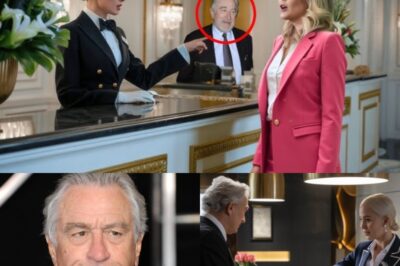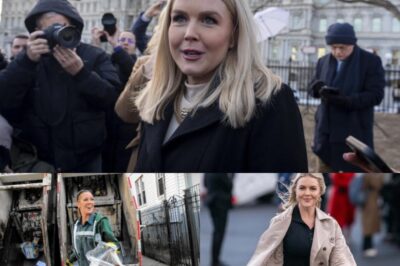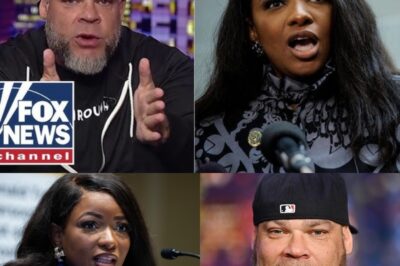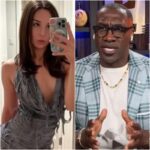The Unveiling at Capitol Hill: Pam Bondi’s Confrontation with Justice Amy Coney Barrett
In the hallowed halls of the Senate Judiciary Committee, a dramatic confrontation unfolded that captivated the nation. Pam Bondi, former Florida Attorney General, took center stage with allegations that could alter the landscape of the Supreme Court. Her claims against Justice Amy Coney Barrett promised revelations about the process behind Barrett’s appointment, stirring political intrigue and public discourse. This is the story of how one woman’s pursuit of transparency led to a showdown that could redefine judicial accountability.

The anticipation was palpable as Pam Bondi approached the podium, her striking blue blazer contrasting with the rich wood-paneled walls. Cameras flashed, capturing her confident demeanor as she prepared to address the committee. Across the room, Justice Amy Coney Barrett maintained her composure, her expression revealing nothing of the turmoil that lay beneath the surface.
“I appreciate the committee granting me time today,” Bondi began, her voice steady and resolute. “I stand before you with evidence that will fundamentally alter our understanding of Justice Barrett’s appointment process.”
A hush fell over the chamber as Bondi reached into her briefcase, extracting a sealed folder marked “Confidential” in vivid red lettering. What followed would forever transform the Supreme Court.
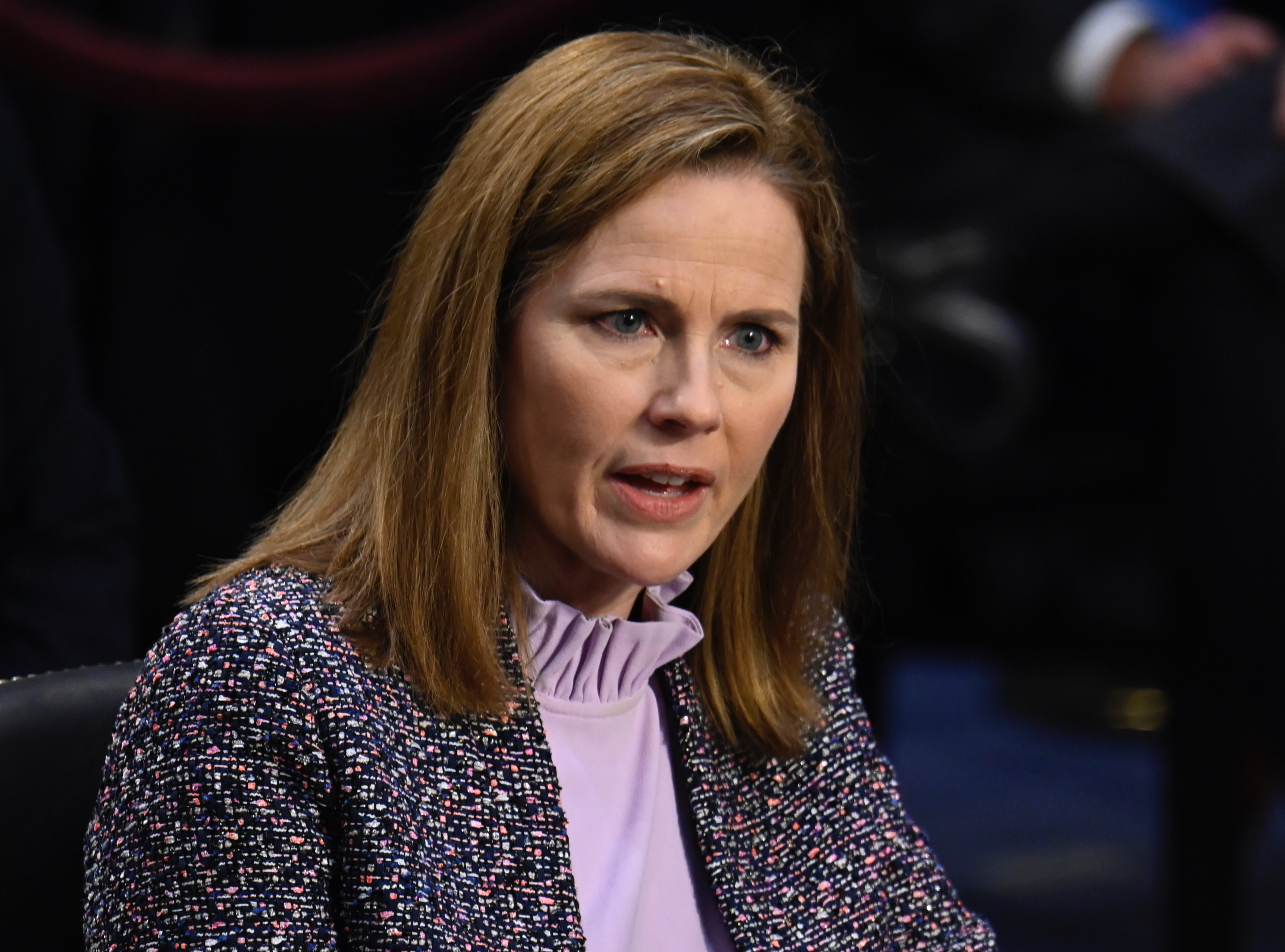
Bondi’s revelations centered around a private agreement made prior to Barrett’s confirmation—a pact never acknowledged publicly. As Bondi opened the folder, the room’s atmosphere shifted. Committee members leaned forward, disbelief etched across their faces.
Justice Barrett’s composure momentarily faltered, her eyes widening as Bondi disclosed the contents. The chairman’s desperate reach for his gavel came too late; the disclosure had commenced.
“These documents reveal a private understanding established before Justice Barrett’s confirmation hearings,” Bondi declared. “One that concerns her approach to certain categories of cases.”
Senator Richard Blumenthal interjected, his tone firm. “Miss Bondi, these allegations are extraordinarily serious. Can you specify the nature of this alleged arrangement?”
Bondi acknowledged the gravity of the moment. “This is an email exchange between two senior officials in the previous administration, dated September 18th, 2020—three days before Barrett’s nomination was officially announced.”
The email discussed a mutual understanding with Barrett concerning how certain cases would be addressed. Though carefully phrased to avoid explicit details, the language strongly suggested assurances had been requested about specific legal positions Barrett would adopt once confirmed.
Justice Barrett leaned toward her microphone. “These emails, if authentic, don’t include me as a recipient, Miss Bondi. I never participated in such discussions.”
Bondi nodded, acknowledging Barrett’s denial. “That’s correct, Justice Barrett. You’re not directly copied. However, the next document addresses that issue.”
She positioned a second page on the projector—a calendar entry revealing a private meeting between Barrett and the officials mentioned in the email, scheduled for the day following the exchange.
The committee chairman intervened. “Miss Bondi, suggesting impropriety based merely on a calendar entry is speculative at best. Supreme Court nominees routinely meet with administration officials during the confirmation process.”
Bondi replied evenly, “Precisely why the third document is most crucial.”
She paused, establishing eye contact with Justice Barrett before proceeding. “This is a memorandum summarizing the meeting, written by one participant and distributed to three others in the administration.”
As the document appeared on screen, audible gasps echoed throughout the chamber. The memo outlined specific legal questions likely to come before the court in the following term and summarized Barrett’s general perspectives on each issue. More troublingly, it referenced mutual commitments ensuring alignment on several controversial areas of law.
Senator Josh Hawley addressed Barrett directly. “Justice Barrett, I must ask you directly, did this meeting occur as described in this memorandum?”
Barrett’s response was measured but tense. “Senator, I participated in dozens of meetings throughout the nomination process. I cannot recall the specific content of each, but I can state unequivocally that I never made commitments regarding future rulings that would violate judicial ethics.”
Bondi pressed further. “Justice Barrett, please examine page three of the memorandum, which specifically mentions your concerns about how these discussions might appear if made public.”
The room grew increasingly silent as Barrett reviewed the passage. The document claimed she had requested absolute confidentiality about certain aspects of the discussion, specifically because they went beyond the traditional bounds of nomination interviews.
Senator Ted Cruz attempted to redirect the hearing. “This entire presentation relies on unauthenticated documents from anonymous sources. How is this appropriate material for a congressional hearing?”
Bondi had anticipated this objection. “Senator Cruz, I understand your concern. That’s precisely why I’ve had these documents examined by two independent forensic analysts.”
She introduced affidavits from digital forensics experts who had verified the metadata and authentication markers of the electronic documents.
Bondi continued, producing another document. “I have a sworn statement from someone present at this meeting, an individual who has only now come forward due to concerns about recent Supreme Court decisions that align precisely with the commitments outlined in these documents.”
The tension peaked as Bondi identified the witness—a former mid-level Justice Department official who had been documenting the meeting but only recently recognized the ethical implications of what had transpired.
Justice Barrett requested a brief recess to review the materials with her counsel. The chairman, noting Barrett’s distress despite her professional demeanor, promptly granted the request.
As Barrett and her legal team exited to a private room, cameras captured the strained expressions of committee members. No one had anticipated the oversight hearing would venture into territory now threatening the legitimacy of the Supreme Court itself.
During the recess, the hearing room erupted with frantic discussions. Democratic senators congregated with their staffers, while Republicans appeared divided—some preparing defenses of Barrett, others distancing themselves from the unfolding situation.
When Barrett returned 15 minutes later, the altered atmosphere was unmistakable. Her characteristic confidence had given way to visible tension, and her legal counsel passed her a handwritten note as she resumed her seat.
As the hearing reconvened, Justice Barrett requested to address the committee before further questioning. The chairman nodded, and all attention focused on the Supreme Court justice.
“I’ve reviewed Miss Bondi’s documents,” Barrett began, her voice steady despite the circumstances. “I take these allegations with utmost seriousness as they challenge judicial independence and the oath I swore to uphold.”
She paused, collecting her thoughts. “The memorandum Miss Bondi has presented contains discussions I neither recognize nor recall. However, rather than issuing a categorical denial, I believe court integrity demands a thorough investigation of these claims.”
The room remained silent, surprised by Barrett’s measured response. Many expected an emphatic denial, not this call for investigation.
Bondi, recognizing her opportunity, approached the critical juncture. “Justice Barrett, I appreciate your willingness to consider these documents. However, there’s one final piece of evidence that I believe will clarify matters substantially.”
She removed a final document from her folder, one deliberately withheld until this moment. “This is a handwritten note that the whistleblower identifies as written by you during the meeting in question.”
Bondi placed it on the projector, and Barrett’s distinctive handwriting appeared on screens throughout the room. The note contained abbreviated points about several legal doctrines, with asterisks beside specific items, including the phrase “maintain conf on points one to three.”
Barrett studied the document, her expression subtly shifting as she recognized her own handwriting. Everyone present held their breath, awaiting her response.
Justice Barrett acknowledged the handwriting but challenged the context. “The handwriting appears to be mine,” Barrett conceded, “but this note has been presented without context. May I approach to examine the original?”
After receiving permission, Barrett rose and approached Bondi’s table, carefully examining the paper under the light. She motioned for her counsel to join her, and they briefly conferred before Barrett returned to her seat, a new certainty evident in her expression.
“Mr. Chairman, committee members, Miss Bondi,” Barrett began, her voice now stronger. “I recognize this document, but not in the context suggested. This appears to be from my personal preparation notes before confirmation hearings.”
Barrett retrieved several similar pages from her own portfolio. “I maintained extensive preparation materials during the confirmation process, as any nominee would. The phrases highlighted by Miss Bondi refer not to secret agreements, but to confidential client matters from my prior legal work that I knew couldn’t be discussed during hearings due to attorney-client privilege.”
She submitted her notes to the committee clerk. “You’ll observe the same abbreviations and marking system throughout my preparation materials. The ‘conf’ refers to confidentiality, not confirmation, as has been suggested.”
Barrett then addressed the memorandum directly. “Regarding the meeting summary Miss Bondi presented, I cannot explain its origins, but I can state unequivocally that it mischaracterizes any conversations during my nomination process. I would never make commitments on future cases that would violate the judicial oath I’ve honored throughout my career.”
The momentum suddenly shifted. Bondi, who had appeared completely in control moments earlier, now struggled to maintain her narrative.
Justice Barrett’s explanations proved decisive. Bondi, visibly shaken, acknowledged, “I received these documents in good faith and had them verified for authenticity. If timeline discrepancies exist, they warrant further investigation. I stand by my concern about judicial independence, but I recognize Justice Barrett has raised legitimate questions about this specific evidence.”
The hearing concluded an hour later, but the aftermath was just beginning. As Barrett exited the committee room, surrounded by Capitol police providing additional security, the hallways buzzed with congressional staffers and journalists attempting to make sense of what they had witnessed.
Within minutes, Barrett’s documents and Bondi’s allegations were trending nationwide. News networks interrupted regular programming to analyze the dramatic confrontation, with legal experts weighing the significance of both the allegations and Barrett’s response.
Conservative media quickly framed the incident as an attempted character assassination of a respected jurist. “Documents Debunked: Justice Barrett Exposes False Allegations,” proclaimed one major right-leaning outlet, featuring footage of Barrett methodically dismantling Bondi’s evidence.
Progressive outlets adopted a more nuanced perspective. “Barrett Refutes Controversial Documents: Questions Remain About Court Independence,” captured their view, acknowledging the specific evidence had been challenged while maintaining broader concerns about the Supreme Court’s direction.
By evening, three significant developments had emerged. First, the Senate Judiciary Committee chairman and ranking member issued a rare bipartisan statement announcing an investigation into the source of the documents presented at the hearing. “While we may disagree on judicial philosophy, we stand united in condemning the use of apparently falsified documents in congressional proceedings,” the statement declared.
Second, FBI forensic analysts were reportedly examining the documents to determine their true origins, particularly focusing on creation timing and whether they represented authentic templates that had been recently modified.
Third, several legal ethics experts published a joint analysis of the incident, noting that regardless of this specific allegation’s accuracy, the episode highlighted deeper concerns about Supreme Court confirmation processes and the absence of binding ethics rules for the nation’s highest court.
Justice Barrett, who had maintained remarkable composure throughout the ordeal, issued a brief statement through the Supreme Court’s public information office. “I appreciate the committee’s willingness to consider all perspectives. The court’s work continues, guided by the Constitution and the rule of law.”
Pam Bondi, facing significant backlash and potential professional consequences, appeared on a sympathetic cable news program that evening to defend her actions. “I presented evidence provided by what I believed was a credible source,” she explained. “If some evidence has been questioned, that doesn’t eliminate the broader concerns about judicial independence that many Americans share.”
The dramatic confrontation between Pam Bondi and Justice Amy Coney Barrett exemplified the challenges of separating fact from fiction in the political arena. Yet paradoxically, the incident ultimately reinforced the importance of evidence, context, and methodical verification in an era of instant allegations and viral outrage.
Six months later, when Justice Barrett authored the majority opinion in a landmark case that contradicted what the falsified documents had claimed she would do, many viewed it as the final vindication of her judicial independence. Others, however, questioned whether public scrutiny had influenced her decision-making in ways impossible to measure.
In America’s charged political environment, accusations can circle the globe before truth has time to put on its shoes. But facts, presented clearly and methodically, still retain the power to prevail.
News
The burger chain is eliminating artificial dyes from its strawberry milkshakes and pink lemonade, replacing them with natural coloring. It’s also in the “process of transitioning” to a new ketchup that uses real sugar instead of high-fructose corn syrup
In-N-Out is removing artificial coloring from two of its drinks and changing its ketchup. The moves come a few weeks…
Just six months after a newborn at Children’s Hospital of Philadelphia was diagnosed with a rare and life-threatening metabolic disorder, doctors were able to develop a personalized treatment involving a first-of-its-kind approach to gene-editing that could end up changing the course of his life — and help others with rare diseases in the future
Just six months after a newborn at Children’s Hospital of Philadelphia was diagnosed with a rare and life-threatening metabolic disorder,…
HOTEL SHOCKER: Liberal Receptionist CANCELS Karoline Leavitt’s Room for Robert De Niro — Then Finds Out Her Husband OWNS the Hotel! She thought she was making a bold political statement… But when a hotel receptionist gave Karoline Leavitt’s reserved suite to Robert De Niro, claiming “policy change,” she didn’t realize one crucial detail:
A Jewel in the Capital: The Story of Redemption at the Wellington Crown Hotel Under the early morning sunlight, the…
An unexpected reunion between Karoline Leavitt and a childhood friend working as a street cleaner. On a bustling street in Washington, D.C., Karoline Leavitt was walking home after a tiring day at the White House when she spotted a familiar figure pushing a garbage cart ahead. Names flashed through her mind, and instinctively, she called out to the worker. A surprising moment unfolded when Clover, her childhood best friend, turned around. The impromptu reunion of the two friends and what Leavitt did for Clover afterward left people amazed and further admiring the young, beautiful press secretary
In a heartwarming moment that has captured the hearts of many, White House Press Secretary Karoline Leavitt experienced an unexpected…
SHOCKING SHOWDOWN: Tyrus Unleashes on Jasmine Crockett—Is This the End of Her Career?
In a stunning on-air clash, Tyrus, a prominent Fox News personality, delivered a brutal takedown of Democratic representative Jasmine Crockett,…
LIVE TV MELTDOWN: Karoline Leavitt vs Cherilyn Sarkisian—The SHOCKING Moment That Left Everyone Speechless! Karoline Leavitt just dropped a BOMB on Cher, and you won’t believe how the iconic star reacted! What was said that turned the debate upside down?
The Unprecedented Showdown: Caroline Leavitt Takes Down Cher on Live TV, Changing the Landscape of American Politics In a stunning and…
End of content
No more pages to load



